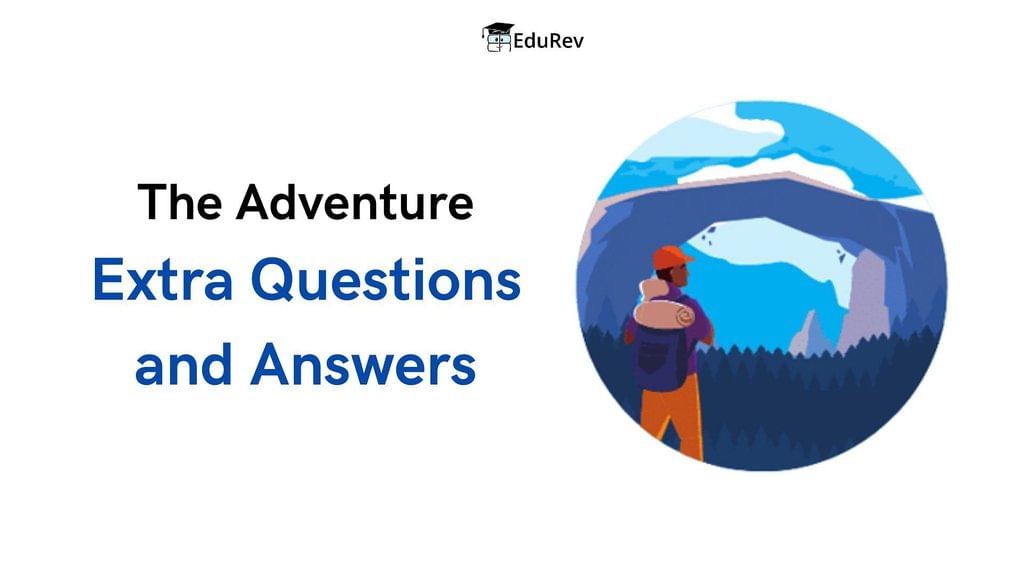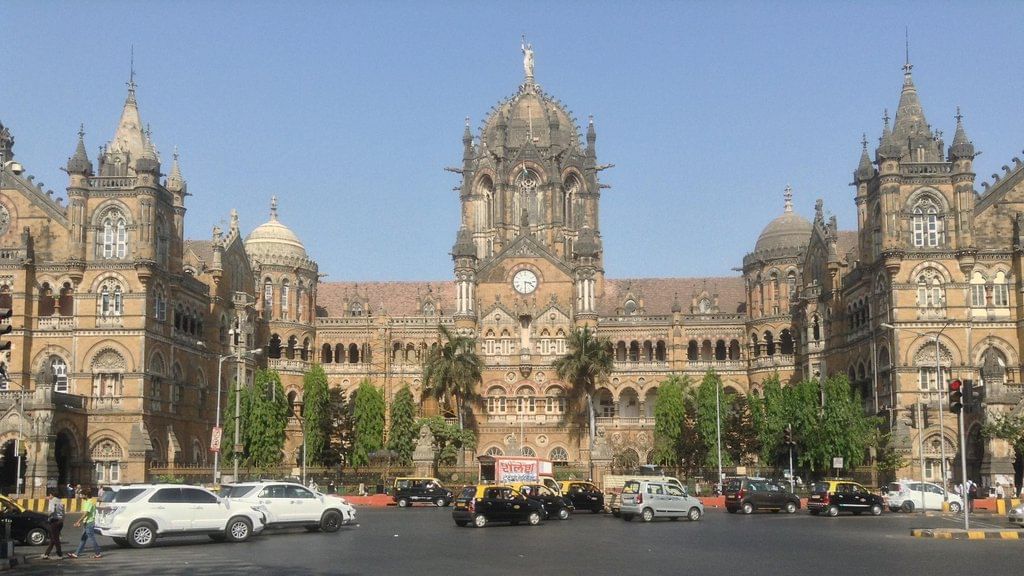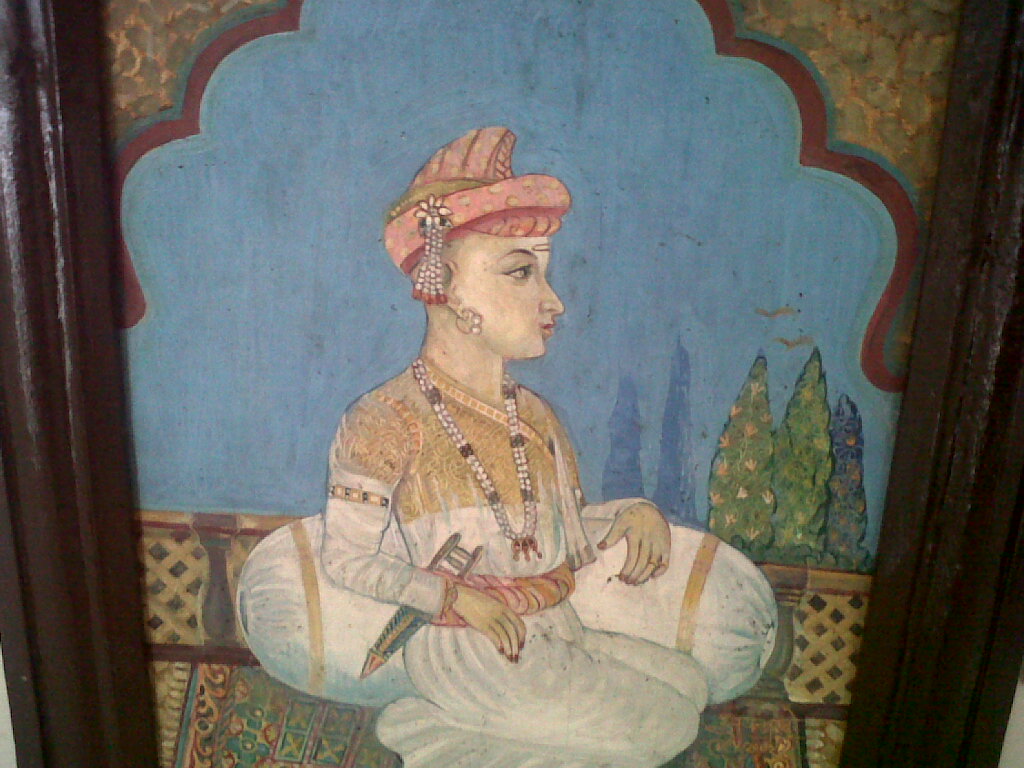Extra Questions and Answers - The Adventure | English Literature for Grade 11 PDF Download
"The Adventure" chapter of Class 11 English by Jayant Narlikar takes readers on an exhilarating journey as Professor Gaitonde, also known as Gangadharpant, time travels and transitions from one world to another. Through a fascinating blend of history and science, we learn about the professor's new world and the lessons he learns along the way.

Short Answer Type Questions
Short question-answer pairs are crucial for students to comprehend the plot, characters, and themes of the story in a focused and concise manner. The following sets of questions and answers can facilitate this process.
Q.1. How had Professor Gaitonde planned to proceed?
Ans. He had intended to visit a major library in Bombay to peruse history books and gain insights into the current state of affairs. Upon his return to Pune, he had planned to engage in a lengthy discussion with Rajendra Deshpande, with the hope of obtaining a clearer understanding of the situation.
Q2. Gangadhar Pant had not been to ‘this Bombay before’. How was ‘the Bombay’ different?
Ans. In contrast to Gangadhar Pant's prior experiences, this particular visit to Bombay occurred during the era of British Raj. The city was distinguished by an Anglo-Indian officer who inspected permits, and the blue carriages of GBMR sported the Union Jack emblem. Moreover, Victoria Terminus appeared remarkably tidy, and the staff was primarily comprised of Anglo-Indians and Parsis, with a few British officers also present.
 Victoria TerminusQ3. What led Professor Gaitonde to believe that ‘history has taken a different turn, perhaps before 1857?
Victoria TerminusQ3. What led Professor Gaitonde to believe that ‘history has taken a different turn, perhaps before 1857?
Ans. Professor Gaitonde noticed an imposing building facing Bombay V.T. It was called East India House, the Headquarters of the East India Company. He knew that the East India Company had been wound up shortly after the events of 1857. Yet here it was not only alive but also flourishing. So he concluded that history had taken a different turn.
Q4. How did the shops and office buildings along Hornby Road differ from those he knew well?
Ans. The Bombay he knew had a tower of OCS building. It peeped above the shorter Victorian buildings. There was a Handloom House also. There were no such buildings along the Road. Instead, there were Boots and Woolworth department stores and offices of Lloyds, Barclays, and other British banks.
Q5. ‘‘This was a blow, not totally unexpected.’’ What was the blow and how was it not totally unexpected?
Ans. At the Forbes building, Professor Gaitonde made inquiries about his son Vinay Gaitonde. The English receptionist searched through the telephone list, the staff list, and the directory of employees of all the branches. She told him that she could not find his name there. This was a blow, but not totally unexpected one. If he himself were dead in this world, his son might not be alive or he might not even have been born.
Q6. Which according to Gangadharpant was the precise moment where history had taken a different turn?
Ans. The victory of the Marathas in the Battle of Panipat was very important. Abdali was defeated completely and pursued back to Kabul by the triumphant Maratha army led by Sadashivrao Bhau and his nephew, the young Vishwasrao.
Q7. ‘‘Gangdharpant read through the account avidly.’’ Which account is referred to here? Why did he read it avidly?
Ans. It was not blow-by-blow account of the battle itself, but its consequences for the power struggle in India. The style of writing was unmistakably Gangadharpant’s own, yet he was reading this account for the first time. So he read it eagerly.
Q8. How did the Victory in the Battle of Panipat affect the balance of power?
Ans. It was a great morale booster to the Marathas. It established its supremacy in northern India. The influence of Bhausaheb and Vishwasrao increased. The East India Company postponed its expansionist program. Vishwasrao and his brother Madhavrao had political sharpness and bravery. The Company’s influence was reduced to small areas near Bombay, Calcutta, and Madras.
Q9. How was the balance of power maintained in the nineteenth century?
Ans. The Peshwas kept the puppet regime alive in Delhi. There were political reasons for it. The Peshwas were the real rulers from Pune. They recognized the importance of the technological age beginning in Europe. They set up their centers for science and technology. East India Company saw an opportunity to increase its influence. It offered aid and experts. These were accepted only to make the local centers self-sufficient.
Q10. What was the state of India Gangadharpant had seen during the twentieth century?
Ans. India moved towards democracy. The Peshwas lost their enterprise. They were gradually replaced by democratically elected bodies. The Sultanate at Delhi survived even this change because it exercised no real influence. The Shahenshah of Delhi held a high position but no real power. He simply gave official approval to the ‘recommendations’ made by the central parliament.
Q11. Why do you think Gangadharpant appreciated India he had seen recently?
Ans. It was an independent and self-respecting country. It had never been enslaved by the white men. It was self-sufficient. It has allowed the British to retain Bombay as their sole outpost. This was due to purely commercial reasons. The treaty was signed in 1908. That lease was to expire in the year 2001.
Q12. Where from did Gangadhar Pant get the clue for the question. ‘‘How did the Marathas win the battle?’’ and what did he think about it?
Ans. He got the clue from a book called Bhausahebanchi Bakhar. He found the Bakhars interesting to read, but he seldom relied on them for historical evidence. The detailed but falsified accounts were quite vivid but truth lay hidden somewhere.
Q13. Which lines revealed that Vishwasrao had come quite close to being killed?
Ans. The lines read: Then Vishwasrao guided his horse to the melee. Elite troops were fighting there. He attacked them. God was merciful. A shot passed by his ear touching it lightly. Even the difference of a til (sesame) would have led to his death. VishwasraoQ14. Why was Professor Gaitonde staring at the platform in Azad Maidan as if mesmerized?
VishwasraoQ14. Why was Professor Gaitonde staring at the platform in Azad Maidan as if mesmerized?
Ans. He found a lecture in progress there. He saw a table and a chair on the platform, but the presidential chair was unoccupied. The sight stirred him to the depths. He could not approve of the public lecture without a presiding dignitary. For him it was a sacrilege.
Q15. How did the audience react to Professor Gaitonde’s remarks: ‘‘An unchaired lecture is like Shakespeare’s ‘Hamlet’ without the Prince of Denmark’’?
Ans. The audience reacted sharply. They were sick of remarks from the chair, of vote of thanks and of long introductions. They had abolished the old customs long ago. Hence that lecture series had no chairperson. The chair was symbolic. They only wanted to listen to the speaker. They asked him to vacate the chair and keep the platform empty.
Q16. What happened as Professor Gaitonde kept on trying valiantly to correct the sacrilege?
Ans. Professor Gaitonde kept on talking and reminding the audience of the importance of presiding dignitary. The hostile audience reacted sharply. First they showered tomatoes, eggs, and other objects on him. Then they rushed to the stage to eject him bodily. He was lost in the crowd.
Q17. Why do you think Rajendra’s ‘smile’ was replaced by a ‘grave expression’?
Ans. Rajendra had smiled on hearing Professor Gaitonde’s strange narrative. Perhaps he thought that Gaitonde’s mind was playing tricks and his imagination was over excited. He became serious as he read a page torn out of a book. This page from Bakhar contained vital evidence about the different turn history had taken.
Q18. What do you think made Rajendra realize that ‘‘facts can be stranger than fantasies’’?
Ans. Professor Gaitonde presented two totally different written accounts of the Battle of Panipat as contained in Bhausahebanchi Bakhar. The one he had come across in the other world described how Vishwasrao narrowly missed the bullet. The other account which he had in the familiar world, described that Vishwasrao was hit by the bullet.
Q19. How does Rajendra explain the disparity in the two accounts of the same crucial event in the Battle of Panipat?
Ans. Rajendra applies catastrophe theory to the Battle of Panipat. The outcome of the battle depended on the leadership and the morale of the troops at the critical juncture. In one of them, the troops lost their morale and fighting spirit at the loss of their leaders. In the other, the bullet missed Vishwasrao and this boosted the morale of the troops and they won.
Q20. ‘‘We live in a unique world which has a unique history,’’ says Professor Gaitonde. What prompts him to make this remark?
Ans. Rajendra tries to explain the outcome of the Battle of Panipat with the help of catastrophe theory. The Marathas might have won it, but actually, they lost it. Napoleon could also have won the Battle of Waterloo, but he was defeated. The idea of ‘it might have been’ is all right for the sake of speculation but not for reality.
Q21. What do you know about ‘reality’ on the basis of your study of Jayant Narlikar’s ‘The Adventure?
Ans. We can experience reality directly with our senses and indirectly via instruments. Reality is not limited to what we see. It may have other forms. Reality may not be unique. This has been found in experiments on very small systems such as atoms and their smallest parts.
Q22. What do you understand by, ‘‘The lack of determinism in quantum theory’’?
Ans. Quantum theory is based on the idea that energy exists in units that can’t be divided. Determinism is the doctrine that all events and actions are determined by external forces acting on the will. The phrase thus means that the energy contained in electrons is not determined by the external forces that fire it.
Q23. How, according to Rajendra, was Gangadharpant able to experience two worlds?
Ans. According to Rajendra, Gangadharpant made a transition from one world to another and back again. By doing so, he was able to experience two worlds, although one at a time. One has the history we know, the other a different history. The separation or bifurcation took place in the Battle of Panipat.
Q24. ‘‘But why did I make the transition?’’ asks Gangadharpant. How does Rajendra try to convince him with guesswork?
Ans. Rajendra has no readymade answer or explanation for this query. He makes a guess. Some interaction is needed to cause a transition. Perhaps Gangadharpant was then thinking about the catastrophe theory and its role in war. Or he may be wondering about the Battle of Panipat. The neurons in his brain triggered the transition.
Q25. What had Professor Gaitonde been thinking at the time of the collision?
Ans. At the time of his collision with the truck, Professor Gaitonde was thinking about the Battle of Panipat. He was wondering what course history would have taken if the result of the battle had gone the other way, i.e. if the Marathas had won the battle.
Q26. What do you learn about Professor Gaitonde’s thousandth presidential address?
Ans. His thousandth presidential address was made on the Azad Maidan. He was then rudely interrupted. He wanted to tell the audience what might had happened if Marathas had won the Battle of Panipat. Since people had misbehaved, he could not deliver this address.
Also Check at EduRev:
Long Answer Type Questions
Long answer type important questions serve as a vital tool in promoting critical thinking, honing writing skills, and improving overall understanding of a subject matter. Successfully answering such questions entails introspection and relating personal experiences, which prepares students for more challenging exams. Therefore, the following Long Answer Type Important Questions can aid in this process.
Q 1. ‘‘Gangadharpant could not help comparing the country he knew with what he was witnessing around him.’’ Elucidate.
Ans. Gangadharpant was an eminent historian of Pune. He had written the History of India in five volumes. During his train journey, he was wondering what course history would have taken if the result of the Battle of Panipat had gone the other way. This helped him to make a transition to the other world. India was an altogether different country in this world. Unlike the India, he knew so well, the India he was witnessing around him was self-sufficient and self-respecting. It was independent. It had never been enslaved by the whites. It had allowed the British to retain Bombay as their sole outpost. This was done for purely commercial reasons. The buildings and offices in this British Bombay were same as in a typical high street of a town in England. East India House, the headquarters of the East India Company was housed in an imposing building outside Bombay’s VT. The station itself looked remarkably neat and clean. The staff mostly comprised of Anglo-Indians and Parsees along with a handful of British officers. The Bombay he knew was altogether different. The tower of OCS buildings peeped above the shorter Victorian buildings. There was Handloom House as well.
Q 2. What, according to Gangadharpant, would have been the consequences if the Marathas had won the Battle of Panipat?
Ans. The consequences of Maratha's victory in the Battle of Panipat would have been far-reaching. It would have boosted their morale and established their supremacy in northern India. The expansionist program of the East India Company would have been shelved. The political cleverness and bravery of Maratha rulers would have helped them to expand their influence all over India. The East India Company would have been reduced to pockets of influence near Bombay, Calcutta, and Madras, just like its European rivals, the Portuguese and the French. The Peshwas would have been the real rulers of India. They would have kept the puppet Mughal government in office for political reasons. Recognizing the importance of the technological age in Europe, they would have set up their own centers for science and technology. The twentieth century would have moved India towards democracy. The Peshwas would have been replaced by democratically elected bodies. The Shahenshah of Delhi would then merely approve the recommendations made by the central parliament.
Q 3. How does Rajendra Deshpande try to rationalize the experience of Professor Gaitonde about his transition to another world and back?
Ans. According to Rajendra, Professor Gaitonde had passed through a fantastic experience, or more correctly, a catastrophic experience. He tried to rationalize it on the basis of two scientific theories that were current then. One was the catastrophe theory. The result of the battle would have been determined by the acts of the leaders and the morale of the troops at the critical juncture. The blow of losing the leaders would have led to a loss of morale and fighting spirit. An utter rout would have followed. If the crucial event had gone the other way, its effect on the troops would also have been the opposite. Their morale would have been boosted and they might have won. The course of history would have been different. The other explanation is the lack of determinism in quantum theory. Catastrophic situations offer radically different alternatives for the world to proceed. All alternatives are viable so far as reality is concerned. However, the observer can experience only one of them at a time. Professor Gaitonde made a transition from one world to the other as he had been thinking about the catastrophe theory and the Battle of Panipat. The neurons in his brain acted as triggers.
If you want to make the most of your studies and get the grades you deserve, then EduRev is a perfect choice!
|
17 videos|192 docs|53 tests
|
FAQs on Extra Questions and Answers - The Adventure - English Literature for Grade 11
| 1. What is the plot of "The Adventure"? |  |
| 2. What is the significance of the title "The Adventure"? |  |
| 3. What is the theme of "The Adventure"? |  |
| 4. What is the message conveyed in "The Adventure"? |  |
| 5. What is the writing style of Jayant Narlikar in "The Adventure"? |  |

|
Explore Courses for Grade 11 exam
|

|


















